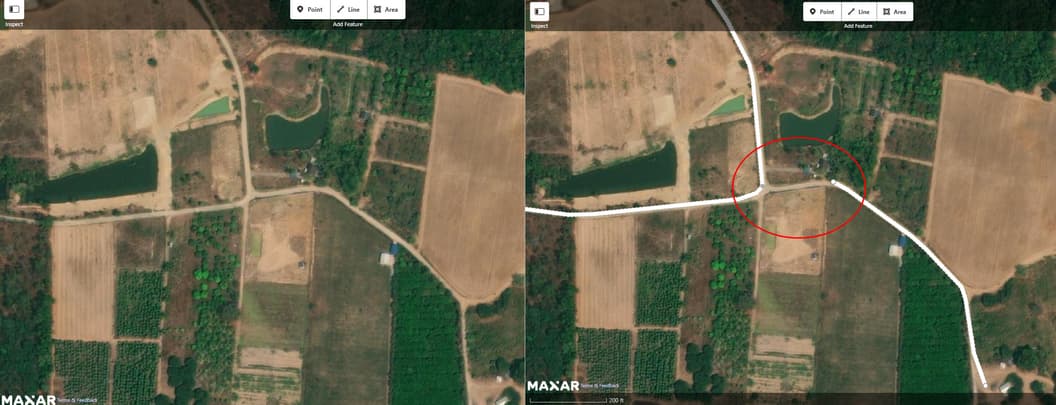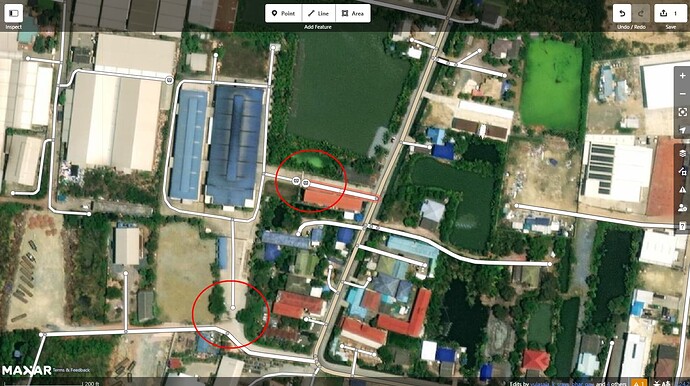Hello @julcnx and @stephankn ,
I am Supannachat from TomTom.
I would like to give you my opinions regarding the Isolated Road MapRoulette challenge, as a Thai mapper who have been mapping for the last couple of years.
Isolated road can hold 2 possible solutions, so either we misconnect them and/or the isolated road does not exist and might have incorrect classified details.
To give you a couple of examples, the trail travelled by bike in the wood; riders cannot take concrete road and appear right on the trail, they must ride through normal road then get through that trail, if it’s possible to imagine this scenario.
Another scenario can be an isolated trail in OSM map, where it is not possible to go there using a bike(trail), you can only walk or track when possible. Then this trail road must be reclassified to foot path or something similar.
Let look at couple tasks of this project below.
- 13.50442,99.62466 where residential road is unconnected. From the imagery, we can clearly see the same surface between existing road and missing road (red circle). I also check with many sources, And I think that we can add the road into this task.
- 13.60626,100.33235, This task is interesting. From the imagery, the missing roads can be added, we can then see that it is private area. If you check it a bit more cautiously, there are fences at 13.605370, 100.331520 and 13.606341, 100.332022 as well, and to avoid not to update the roads and make routing like shortcut going through private area, I think this case after connecting the roads we need to add ‘access:private’ into roads in private area.
I have fixed 3-4 tasks so far and I think that I would skip some tasks with no source support at all, which will give us some proof points to analyze internally and improve our processes. Some tasks are editable and better to fix rather than eliminate the violations.
The project is not for remote mappers indeed, and our intension is for everyone, either Thai or foreigners with more local knowledge and footprint is welcome to edit, even we can discuss with GRAB and Bolt on support that will gain all of us benefits to fix those isolated roads.
Salim and myself will be available and welcoming any inquires and questions that you might still have , and we are always encouraged and motivated to have a constructive dialogue
สุพรรณ์ฉัตรจาก TomTom นะคะ
ขอออกความคิดเห็นเกี่ยวกับโปรเจ็คแก้ถนนลอย หรือ Isolated Road ในฐานะคนทำงานแผนที่มาหลายปีดังนี้นะคะ
ถนนลอย (ต่อจากนี้จะเรียก Isolated road) มีความเป็นไปได้สองอย่างคือเราลืม connect ให้มันหรือในความเป็นจริงถนนอันนี้ไม่มี หรือไม่เราก็อาจจะเราใส่ road class มันผิด ถ้ามันอยู่ตรงนั้นจริงๆ
ยกตัวอย่างความน่าจะเป็นสองอัน
แบบแรกเราเห็น trail ลอยๆอยู่กลางป่าใน OSM Map แต่ในความเป็นจริงคือ เรามีถนนเข้าไปยัง isolated trail เส้นนั้น แต่แค่ connection มัน missing อยู่ ฉะนั้นในเคสนี้วิธีแก้ก็คือ สร้าง missing road
แบบที่สอง มี isolated trail อยู่กลางป่าเหมือนเดิม แต่ในความเป็นจริงคือ ไม่มีทางที่รถสามารถเข้าไปได้เลย ต้องเดินเข้าไปเท่านั้น ถนนที่ลอยอยู่ควรเปลี่ยน class ไปเป็นทางเดิน (Foot Path) เพื่อความเหมาะสม เพราะในความเป็นจริงเราไม่สามารถขี่มอเตอร์ไซค์อยู่บนถนนคอนกรีตอยู่ดีๆแล้วกระโดดไปที่ตำแหน่ง isolated trail กลางป่าได้ทันที ยังไงก็จะถนนต้องมีทางไปเสมอ หรือไม่ก็เป็นซอยตัน
จะหยิบตัวอย่างของ task ใน project มาพูดถึงสองอันนะคะ
ตัวอย่างแรกที่ 13.50442,99.62466 ตรงที่วงสีแดงไว้คือต้องตัดสินใจว่าควรแก้หรือไม่ เคสนี้พอลองปิด road layerดูจะพบว่า ลักษณะพื้นที่ ของภาพถ่ายดาวเทียมบริเวณมีถนนกับไม่มีถนนไม่ต่างกันเลย และเป็นรูปแบบถนนชัดเจน เคสนี้เลยสร้างถนนตรงวงกลมสีแดงค่ะ
ตัวอย่างที่สอง 13.60626,100.33235 ถนนลอยๆอยู่ในพื้นที่ที่น่าจะเป็นพื้นที่ส่วนบุคคลแน่นอน ซูมดูใกล้ๆตรง 13.605370, 100.331520 และ 13.606341, 100.332022 มีประตู แต่ในความเป็นจริงเราก็ต้องขับรถผ่านถนน ผ่านเข้าประตูเข้าบ้านไปอยู่แล้ว ในกรณีนี้จึงพิจารณาใส่ access:private เพิ่มในถนนส่วนบุคคลให้ด้วย เพื่อที่ routing จะได้ไม่ route ผ่านพื้นที่ส่วนบุคคลของใคร
ระหว่างที่รีวิวงานก็ได้ทำ task ไป 3-4 task นะคะ และอาจจะข้าม task บางอันที่หา source ไม่เจอ และจะรวบรวม task ที่แก้ไม่ได้ ไปวิเคราะห์เพิ่มเติมหลังบ้านค่ะ โดยรวมโปรเจคนี้มี task ค่อนข้าง valid พอสมควร สามารถแก้ได้เลยดีกว่าทิ้งถนนลอยไว้ให้มี error ไว้รอ survey ค่ะ
ะเพิ่มเติมนะคะ โปรเจคนี้จริงๆแล้วไม่ใช่สำหรับ remote mappers ค่ะ ความตั้งใจของเราคือเราอยากให้ทุกคนไม่ว่าจะเป็นคนไทย ต่างชาติที่อาศัยในพื้นที่นั้นๆ มาร่วม edit ค่ะ ทาง Grab หรือ Bolt เราก็พร้อมคุยค่ะ คิดว่าทุกฝ่ายจะได้ประโยชน์ในการแก้ isolated road แน่นอน
ซาลิมกับดิฉันอยากให้ทุกคนเข้ามาร่วม edit กันนะคะ และพร้อมตอบทุกคำถามที่เกี่ยวกับโปรเจคนี้ ใครมีข้อสงสัยสามารถพิมพ์คำถามทิ้งไว้ได้เลยค่ะ
Cheers,
Supannachat

